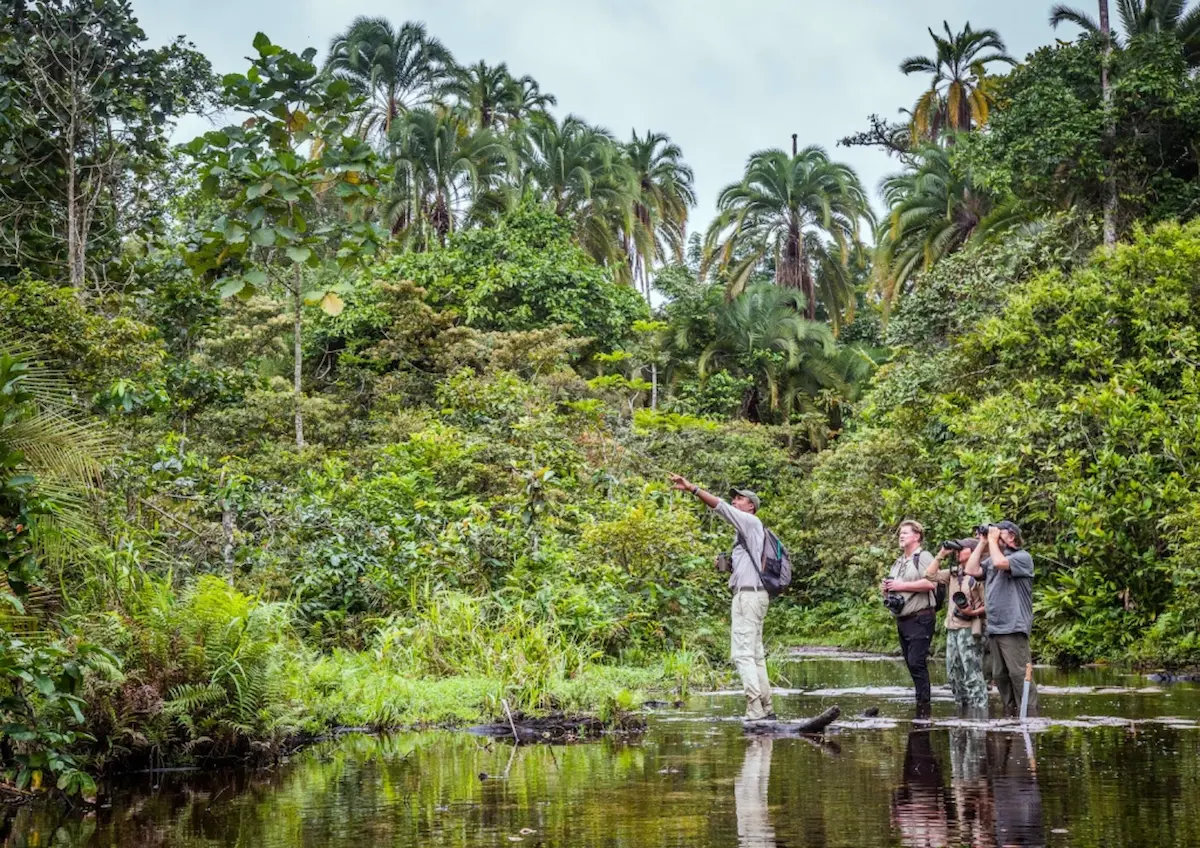In the Congo Basin, the black heart of Africa, the tour operator Kamba African Rainforest Experience combines the safari concept with active nature conservation and the preservation of biodiversity in Odzala-Kokoua National Park. The national park is located in the north-west of the Republic of Congo in the second largest tropical rainforest in the world.
Tropical rainforest
Tropical rainforests are also known as the "green lungs" of the planet because they store large amounts of CO2 and release oxygen into the air in return. They are characterised above all by the fact that they are always moist. The tree population is almost exclusively characterised by deciduous trees, the canopy is very dense up to a height of 40, sometimes up to 60 metres, and there is a high level of competition for the basis of life: light. Accordingly, the area close to the ground is very dark, with mostly impenetrable herbs and bushes. The humus layer is relatively thin and the nutrient situation is correspondingly poor. An example: without a more or less constant supply of desert dust (500 million tonnes per year) from the Sahara, which is transported over the Atlantic at high altitude, the Amazon rainforest would probably be a sparse grove or a savannah. The "delivered" substances - iron and phosphorus compounds - are largely absorbed by fungi (mycelium in the soil) and released to the chlorophyll-bearing plants in exchange for sugar. The same applies to the Congolese jungle.
Tropical rainforests are found along the equator and a strip up to about the tenth degree of latitude north and south. South America, Central and East Africa and South-East Asia are the three main areas of occurrence. In total, tropical rainforests cover around 9% of the land area, and unfortunately the trend is clearly downwards. Due to their geographical location, rainforests have no seasons and therefore no major fluctuations in temperature or day length. Tropical forests are considered to be extremely rich in vegetation and fauna, with between 40 and 60 per cent of all species occurring in the tropical rainforest. Their ecological value lies not only in their function as air purifiers and carbon sinks, but also as heat sinks and water reservoirs, but above all as a place of unrivalled biodiversity: Slash-and-burn agriculture, overexploitation of tropical timber, soya cultivation, grazing, over-tourism and the extraction of mineral resources.
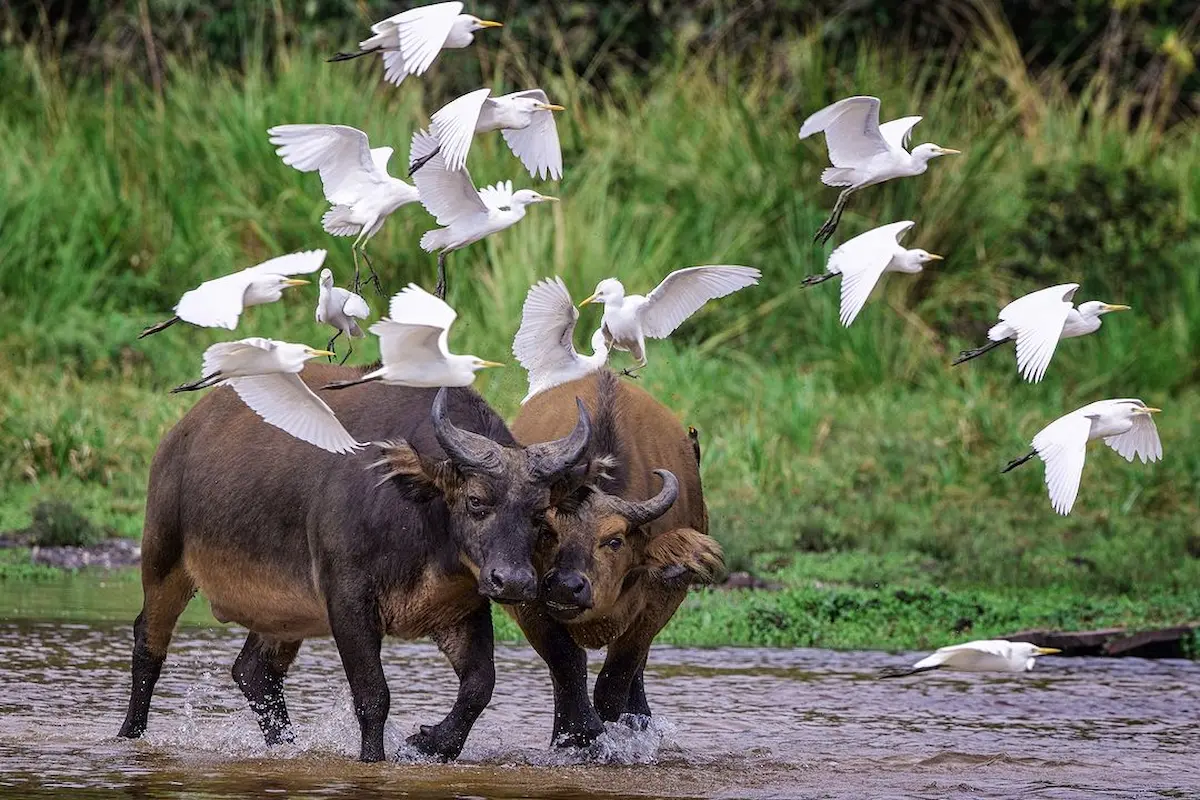
Odzala-Kokoua National Park
The 13,600 km² Odzala-Kokoua National Park is located in the Republic of Congo at around 400 to 600 metres above sea level and is the second largest fully intact lowland rainforest in the world as well as one of the world's oldest nature reserves, founded in 1935 under French colonial rule. It has had the status of a UNESCO biosphere reserve since 1977 and has been listed as a UNESCO World Heritage Site since 2023. Due to its inaccessibility, the area is almost free of human settlement and hardly exposed to the dangers of logging and deforestation, a real carbon sink.the Congo's river/forest landscape is characterised by the large amounts of rainfall, which are caused by the vegetation itself in addition to the water masses flowing in from outside. This consists of tropical rainforest with many clearings and branching and meandering watercourses of the Congo and its tributaries. Odzala National Park is home to forest elephants, bongos, sitatungas, crowned duikers, spotted hyenas, lions, leopards, buffaloes, giant forest hogs, brush-eared pigs and numerous species of monkeys including gorillas and chimpanzees. Odzala-Kokoua is home to 400 bird species, 114 mammal species and over a thousand plant species. Flooded clearings with a high concentration of minerals and salts provide the best places to view the rainforest's animal inhabitants, as the animals often visit them to drink and absorb minerals.
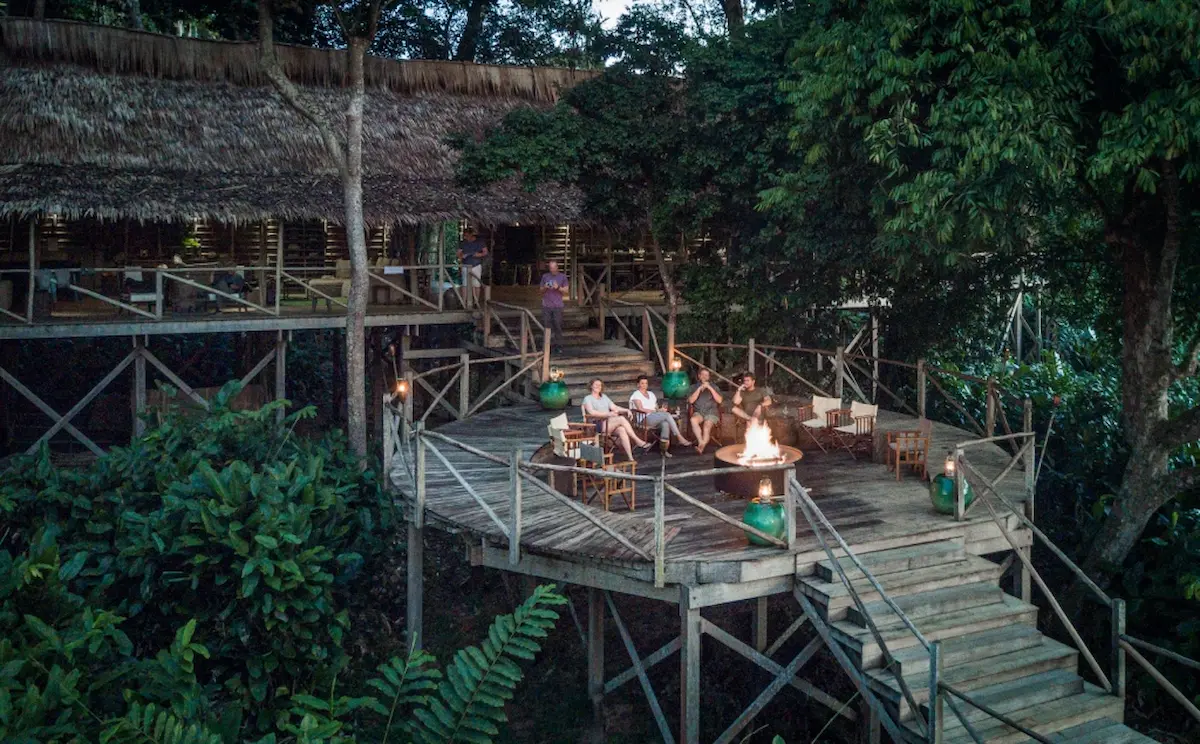
Kamba African Rainforest Experience
In Odzala National Park, the tour operator Kamba African Rainforest Experience combines the safari concept with active nature conservation. In three lodges, up to twelve people each have the opportunity to get to know tropical rainforest, unspoilt river and floodplain landscapes or open savannah up close. It is important to the organiser not only to convey unforgettable impressions, but also to achieve a deeper understanding of the local flora and fauna in their complex interplay and the threat to their diversity. This also applies to the local population through the support of local communities.
So-called Discovery Camps serve as accommodation and starting point for safari tours through the rainforest. The Ngaga, Lango and Mboko lodges are located in areas of the park that are characterised by different landscapes. Ngaga is located in the dense jungle, Mboko lies in a savannah strip. And Lango is a destination characterised by swamps and meandering waters. Two rainy seasons, one between March and May and the other between September and November, determine the park's weather patterns. During the rainiest months of May and November, the safari camps in the national park are closed.
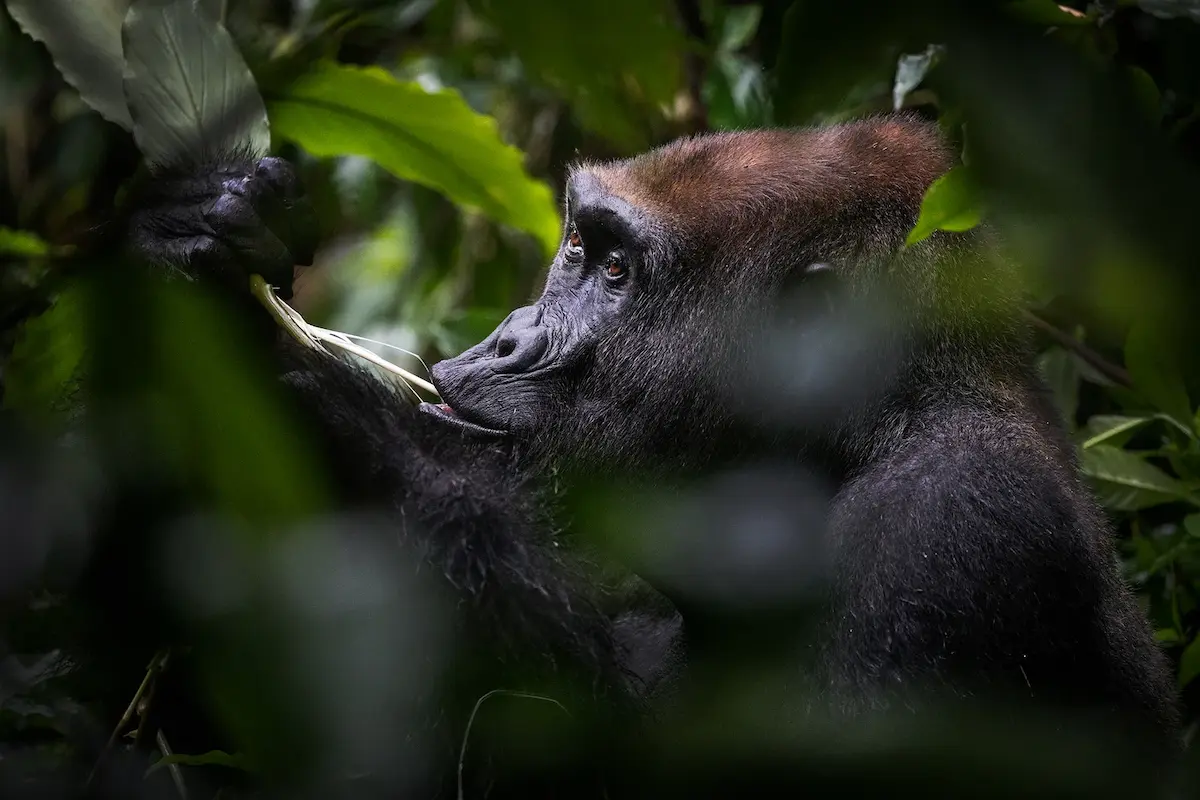
Gorilla-Tracking
Gorilla tracking is the main activity in Ngaga. Groups of a maximum of four participants are guided to the apes' favourite places in such a way that they are not disturbed in their rhythm of life. In Ngaga there is also a research centre dedicated to primatology, which is also part of the Kamba resort.
The western lowland gorillas living here differ from their eastern neighbours in their build and fur colouring. They have a somewhat more delicate build and are grey-brown rather than black with a brown "headdress". They climb trees more often than their relatives and are more territorial. Two large families, each with a head and around 15 and 24 members respectively, roam the local rainforest near the Ngaga Lodge in search of food, especially plants. Even though their population is larger than that of other gorilla species, the IUCN classifies them as an endangered species.
In addition to the gorillas, numerous hoofed animals such as water buffalo, antelopes and forest elephants live here, as well as large predators such as lions, leopards and hyenas, water and brush-eared pigs and chimpanzees. Birdlife is also abundant.
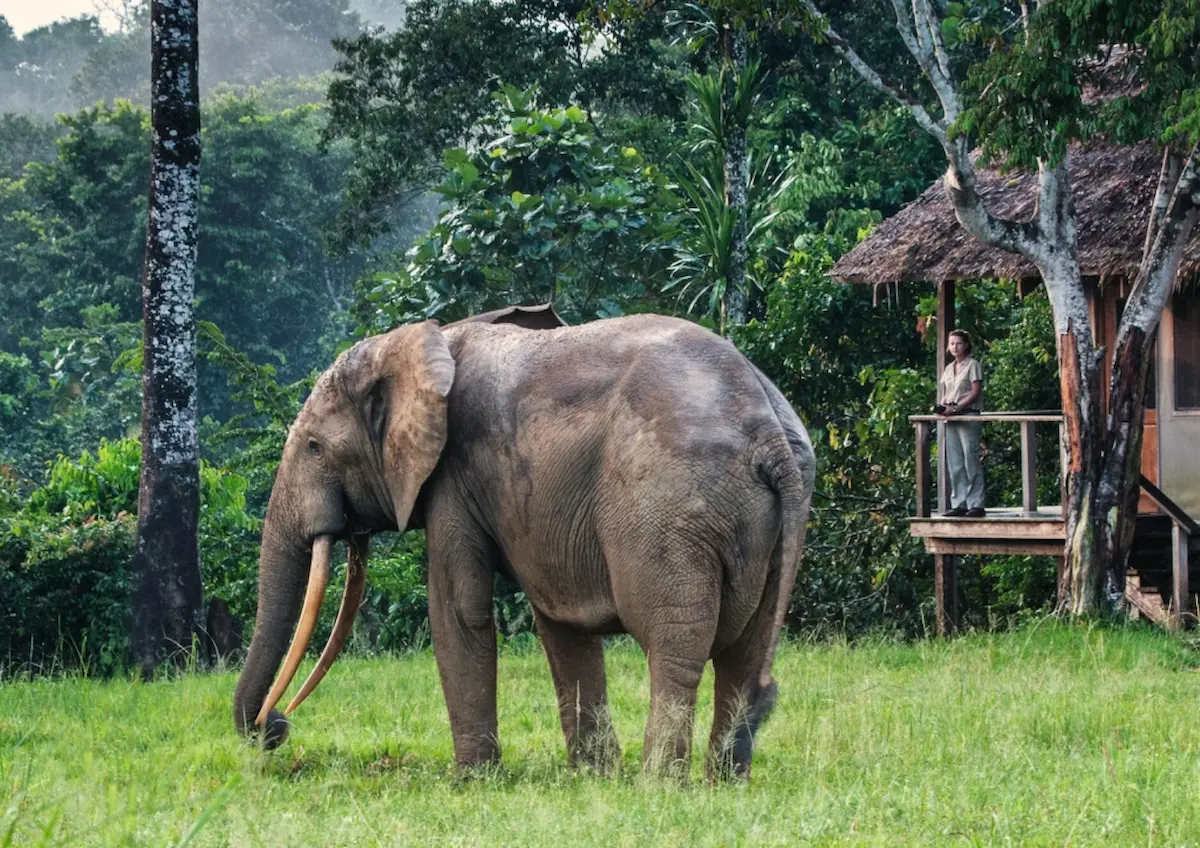
The mission of Kamba
Kamba's mission is to create awe-inspiring experiences while advancing the conservation of the Congo Basin. By empowering local communities, developing sustainable tourism models and creating transformative experiences for guests, Kamba aims to change the way we see the world and foster a deeper appreciation for nature. This is realised through the KARE framework:
- Knowledge: Unforgettable experiences raise awareness of the importance of the Congo Basin as a carbon sink and habitat for rare species.
- Advancement: The financing of education, health and training opportunities for the local population promotes economic independence and the preservation of the traditional way of life.
- Research: Supporting scientific projects, especially through the research station in Ngaga, helps to deepen the understanding of biodiversity and protect endangered species.
- Ecotourism: Create sustainable economic opportunities that protect the rainforest from destructive activities such as logging and poaching.
Text: Werner Köstle/Kamba
Images: Kamba/Scott Ramsey, Andy Skillen, Andrew Howard

